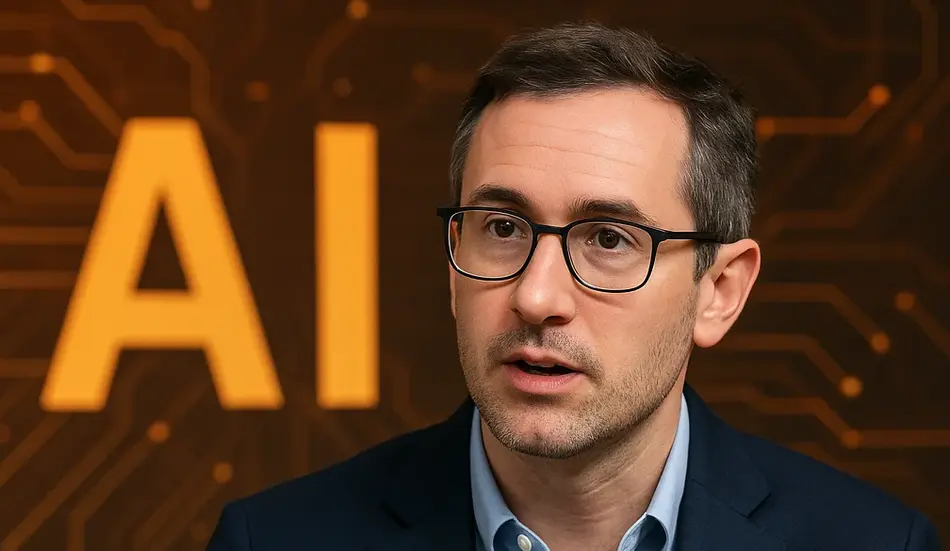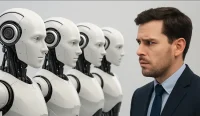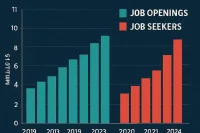Why this investor says the AI boom isn’t the next .com crash
Why this investor says the AI boom isn’t the next .com crash is a question that’s been on everyone’s mind as hundreds of billions of dollars pour into artificial intelligence infrastructure. Martin Casado, General Partner at Andreessen Horowitz and head of their billion-dollar infrastructure practice, offers a compelling argument for why today’s AI investment frenzy differs fundamentally from the dot-com bubble that burst in the early 2000s.
While the current AI boom shares some surface similarities with the late 1990s tech bubble—massive investment, cultural excitement, and new company formations—Casado argues that the underlying fundamentals are dramatically different and much stronger this time around.
Where the AI money is actually going
To understand why the AI boom might be different, it’s crucial to understand where the money is flowing. According to Casado, the vast majority of AI investment is going into actual data-center capacity:
- GPUs and hardware infrastructure
- Real estate for data centers
- Power systems and electrical infrastructure
- HVAC systems to cool the equipment
- Software development and team costs
This is fundamentally different from the dot-com era, where much of the investment went into speculative companies with unproven business models and little actual infrastructure.
The key differences from the dot-com crash
Casado identifies several critical differences between today’s AI boom and the dot-com bubble that suggest we’re not headed for a similar crash:
1. Strong balance sheets vs. massive debt
During the dot-com era, much of the infrastructure was provided by companies like WorldCom, which had $40 billion in debt and was essentially cooking the books. Today, the companies investing in AI infrastructure have:
- Hundreds of billions of dollars on their balance sheets
- Strong cash flow from existing businesses
- Proven track records of infrastructure investment
As Casado notes, “These companies spend lots of money on infrastructure historically. And so, like, maybe they’re inflating it. But these companies have, you know, great balance sheets, great cash flow.”
2. Existing businesses vs. unproven models
Unlike the dot-com era, where most companies had no clear path to profitability, today’s AI investments are being made by companies with established, profitable businesses. The AI spending represents a shift in budget allocation rather than entirely new spending.
Casado explains: “The companies that are implementing a lot of this AI spend have existing businesses, right? And the AI portion has to grow 40X, which is a lot. But it is actually not a lot relative to their businesses.”
3. Proven demand vs. speculative adoption
During the dot-com era, there were many internet users but few people actually paying for internet services. Today, AI services are already generating significant revenue, and the demand is proven rather than speculative.
Addressing the debt concerns
One of the major concerns about the current AI boom is the massive debt being taken on to fund infrastructure. Recent reports show:
- OpenAI discussing $1 trillion for data centers
- Bain consultants estimating 2 trillion in annual AI revenue by 2030 needed to justify current spending
- Meta planning to spend up to $600 billion by 2028
However, Casado argues that this debt is fundamentally different from the dot-com era because it’s being taken on by companies with strong existing businesses and cash flow, not speculative startups with no revenue.
Distinguishing between speculative bubbles and systemic collapse
Casado makes an important distinction between two different types of market problems:
Speculative valuation bubbles
These are periods when stock valuations become inflated relative to fundamentals. Casado acknowledges that these happen regularly and are normal market behavior. “Valuations often get the timing wrong, they wax and they wane,” he says.
Systemic collapse
This is when the entire financial system faces a crisis due to over-leveraged companies and unsustainable debt structures. The dot-com crash was caused by a combination of factors:
- WorldCom’s $40 billion in debt and accounting fraud
- A fiber glut and subsequent bust
- The 9/11 terrorist attacks
- Companies with no clear path to profitability
Casado argues that none of these systemic risk factors exist in today’s AI boom.
Stay Prepared in a Shifting Market
Whether markets are in a speculative bubble or facing systemic risks, your career doesn’t have to be uncertain. Explore stable opportunities on WhatJobs and position yourself for growth—no matter how the market moves.
Search Jobs Now →The concentration risk argument
One concern raised about the current market is the unprecedented concentration in the stock market, with the top five companies (all tech companies) representing a huge portion of total market value. However, Casado points out that this concentration actually makes the system more stable, not less:
- These companies have strong balance sheets and cash flow
- They’re not dependent on external financing
- They have proven business models
- They’re investing in infrastructure that supports their existing businesses
The 40X growth challenge
One of the most concerning statistics is that AI revenue needs to grow 40X in the next four years to justify current investment levels. However, Casado argues this is less daunting when viewed in context:
It’s a budget shift, not new spending
Unlike the internet, which required entirely new spending and new companies, AI represents existing companies shifting their budget allocation from one area to another. As Casado explains:
“Let’s not confuse something like the internet, which was kind of like a net-new behavior, net-new spend, net-new companies drove basically all of it with existing companies that are shifting spend from one column to another column, which is actually what we’re seeing.”
Historical precedent
Casado points out that we’ve seen similar massive shifts in technology spending before—in mobile, cloud computing, and SaaS—without systemic collapse. These shifts were absorbed by the market and ultimately justified by the value they created.
The generative AI difference
Casado argues that the current AI wave is fundamentally different from previous AI attempts because of the generative capabilities:
Previous AI limitations
For decades, AI provided modest improvements (like 20% better fraud detection) but didn’t create new behaviors or significantly better user experiences. As Casado notes, “It’s been a technology that like large can use to get 20% better.”
Generative AI breakthrough
The current wave of AI is different because it:
- Creates entirely new behaviors
- Provides 1,000x improvements over traditional methods
- Enables creativity and emotional connections
- Opens up new use cases and markets
This creates the conditions for “super cycles” where new generational companies can emerge, similar to what happened with the internet.
Investment opportunities in AI
Casado sees significant opportunities across the AI landscape, but emphasizes that it’s not just about the large language models:
State-of-the-art models
Companies like OpenAI and Anthropic require massive capital but represent the cutting edge of AI capabilities.
The long tail of AI companies
Casado is particularly excited about companies working on:
- Image diffusion
- Video generation
- Speech synthesis
- Music generation
- Other specialized AI applications
These companies often have better economics and more defensible positions than the large language model companies.
The coffee pot analogy
Casado uses a powerful analogy to explain why current AI applications that seem trivial might actually be significant:
The first web video
In the mid-1990s, the first video on the web was a live webcam of a coffee pot at Cambridge University. It seemed silly and trivial, but it demonstrated the potential for video streaming that would later become Netflix and YouTube.
Current AI applications
Similarly, today’s AI applications—from anime generation to creative tools—might seem trivial, but they represent the early stages of technologies that will become fundamental to how we work and live.
As Casado explains: “We see a lot of like anime and a lot of silly-use cases. And then we tend to poo pooh this as like, oh, this isn’t serious stuff, and where are the enterprise use cases, and blah blah blah. But like, this is what the future always looks like.”
The changing nature of venture capital
Casado also discusses how the venture capital landscape is changing, which affects how we should think about AI investments:
The IPO problem
Many of the best AI companies are choosing not to go public, instead staying private with access to abundant capital. This creates new challenges for VCs who traditionally relied on IPOs for exits.
New exit strategies
Venture capitalists are now exploring new ways to provide liquidity to their investors, including secondary sales and other private market transactions.
What the future holds
Looking ahead 20 years, Casado believes we’ll tell a story similar to the internet’s evolution—from seemingly trivial applications to fundamental infrastructure that transforms how we live and work.
The pattern of technological adoption
History shows that transformative technologies often start with applications that seem silly or trivial but demonstrate the potential for much larger changes. The web started with dancing hamsters and coffee pot cameras, but became the foundation for the modern economy.
AI’s potential
AI is already showing signs of similar transformative potential, with applications in creativity, communication, and problem-solving that were previously impossible with computers.
FAQs
Q: How is the AI boom different from the dot-com bubble?
A: The key differences include strong balance sheets vs. massive debt, existing profitable businesses vs. unproven models, and proven demand vs. speculative adoption. Today’s AI investments are made by companies with strong cash flow, not speculative startups.
Q: What about the massive debt being taken on for AI infrastructure?
A: While the debt levels are high, they’re being taken on by companies with strong existing businesses and cash flow, not speculative companies with no revenue. This makes the debt much more sustainable than during the dot-com era.
Q: How can AI revenue grow 40X to justify current investment?
A: The 40X growth is less daunting when viewed as a budget shift rather than new spending. Companies are reallocating existing budgets from other areas to AI, rather than creating entirely new spending.
Q: What makes generative AI different from previous AI waves?
A: Previous AI provided modest improvements (20% better performance), but generative AI creates entirely new behaviors and provides 1,000x improvements over traditional methods, enabling creativity and emotional connections.
Live example — user point of view
As someone who’s been following the AI investment landscape closely, I found Martin Casado’s perspective really refreshing. I’ve been worried about the massive spending on AI infrastructure and whether it’s sustainable, but his analysis helped me understand why this time might be different.
What struck me most was his point about budget shifts versus new spending. I hadn’t really thought about it that way before, but it makes sense. Companies like Meta and Google aren’t creating entirely new budgets for AI—they’re reallocating money from other areas of their business. That’s very different from the dot-com era when companies were spending money they didn’t have on business models that didn’t exist.
I also appreciated his distinction between speculative bubbles and systemic collapse. I think a lot of people conflate these two things, but they’re very different. A speculative bubble means some stocks are overvalued, which is normal market behavior. A systemic collapse means the entire financial system is at risk, which is what happened in 2001.
The coffee pot analogy really resonated with me too. I remember thinking that early internet applications like dancing hamsters were silly and wouldn’t lead anywhere. But looking back, those seemingly trivial applications were actually demonstrating the potential for much larger changes. I think we’re seeing something similar with AI today.
Overall, I’m still cautious about AI investments, but Casado’s analysis gives me more confidence that we’re not headed for another dot-com crash. The fundamentals do seem much stronger this time around.




